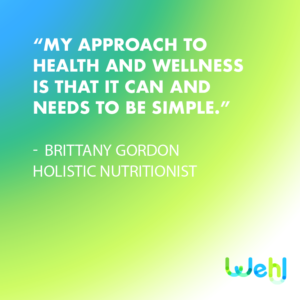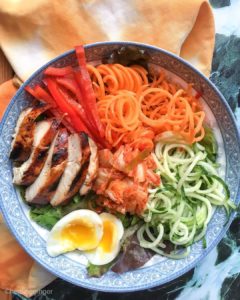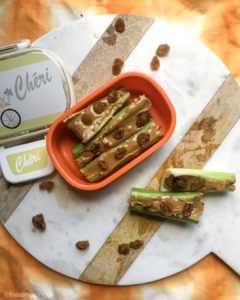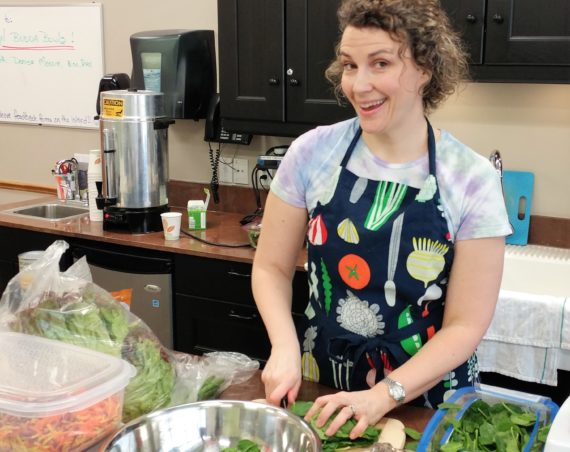Allergies, food sensitivities and skin health issues are struggles many of us have and we’re not alone. Brittany Gordon has had her own personal struggles and experience with allergies and skin health issues. This inspired her to become a holistic nutritionist to help support others in their personal health and fitness goals through sport nutrition programs, allergy relief programs, weight-loss protocols, and general nutritional education and awareness.
We chatted with Brittany about how allergies can show up in your body, the connection between allergies and skin health, and foods that can help reduce inflammation.
WEHL: Tell us a little about yourself and why you became interested in holistic wellness.
BG: My name is Brittany Gordon and I am a Registered Holistic Nutritionist. I came to the practice of nutrition after years of struggling with my own chronic eczema, mild to severe allergies and other issues associated with chronic inflammation. As an avid runner, personal trainer and yoga teacher, I didn’t want to be held back by achy joints or inflamed skin. Because of this drive to optimize my own health, I am now gratefully in a position where I am able to help others with heart and assist them in learning how to take control of their lives and develop healthy and vibrant nutrition habits.
WEHL: What is your philosophy on wellness?
BG: My approach to health and wellness is that it can and needs to be simple. Often in an effort to optimize our health we embark on overly complicated diet/meal plans. We unnecessarily restrict and remove foods from our diets in the hopes that it will make us feel better/feel our best. I aim to remove and reduce the mystery and confusion around the foods we eat and help my clients come back to what is simple, basic and delicious.

WEHL: Why did you decide to become a holistic nutritionist?
BG: Growing up I was raised by a mom who always believed in using natural methods to make us feel better. I grew up with allergies to foods but also to many different medicines and because of this my mom rarely relied on Western Medicine to remedy our colds. It was normal for me to look towards herbs and nutrition as a way to maintain health, and maybe partly because of this I was attracted to holistic nutrition.
WEHL: Why did you want to have a special focus in your practice on allergies and skin health?
BG: When I began to practice nutrition I had decided that my main focus would be allergies and skin health because of my own life experiences. Allergies and skin health are both very sensitive topics; as someone that grew up with severe eczema, food sensitivities and anaphylactic allergies I had experienced the spectrum of health and medical practitioners ranging from very sympathetic to those individuals who just didn’t seem to get it. Having experienced working with less than sympathetic health and medical practitioners, I wanted to be able to provide my clients with a safe space where they could feel heard and supported while learning how to navigate their allergies and manage their inflammation.
 WEHL: What are allergies and what can you do about them?
WEHL: What are allergies and what can you do about them?
BG: Allergies in simple terms means your body’s immune system is having an overreaction to a substance that should be harmless in the body. With the rise of environmental and food sensitivities some confusion has arisen and I think this would be a great opportunity to clarify.
A true allergic response, such as anaphylaxis, read life threatening, is governed by immunoglobulin E (IgE). On the other hand a food or environmental sensitivity is governed by immunoglobulin G (IgG), these are referred to as sensitivities because the reactions aren’t as severe, and typically range from a headache, to upset stomach and can set off an inflammatory response but would not be life threatening.
Now that we know a bit more about the difference between an allergy and a sensitivity, what can you do about it? Well, the truth is unfortunately there isn’t much that you can do; currently advice for living with allergies or sensitivities is to avoid the substance that causes you to have a reaction. For people with dust allergies that means regular cleaning/dusting and maybe even buying an air purifier to reduce dust particles; for food allergies that means avoiding the food and any potential cross contamination.
WEHL: How do food allergies compare to environmental allergies?
BG: When it comes to how your body reacts to food allergies and environmental allergies the same over-reactions of the immune system are occurring. However, it is much less likely to see someone with say an anaphylactic reaction to dust than it would be for someone to be anaphylactic to nuts or dairy. Although the reactions aren’t commonly as severe as some known food allergy reactions such as rash, hives, eczema, psoriasis, respiratory issues (asthma), they are very common and quite unpleasant to have to manage and deal with. All this to say, environmental allergies go way beyond just itchy eyes and a runny nose.

WEHL: How can allergies show up in the body?
BG: The way in which a true allergic response can show up in the body is extremely diverse and when we start to consider food and environmental sensitivities the net of potential symptoms and reactions begins to be cast quite large. For example, symptoms can range from itchy eyes and runny nose all the way to the other end of the spectrum which would be much more life threatening such as asthma attacks and anaphylaxis.
WEHL: Why does it seem like food allergies are more common these days?
BG: It seems like food allergies are more common these days because they are. The CDC noted that from 1997 to 2011 the increase in allergies among children was up by 50% and peanuts and tree nut allergies have almost tripled. From testing out new strategies to manage allergies to diving deeper into what might be causing this upswing, professionals in both medicine and science are trying to figure it out, so hopefully soon we will have more management and prevention strategies.
WEHL: What are some of the most common food allergies and what’s the best way to test for them?
BG: There is a list of the top 8 allergens; they are considered the top 8 because they make up about 90% of all allergies. The top 8 are: milk, eggs, peanuts (which are legumes), tree nuts (walnuts, almonds, cashews, etc.), fish, shellfish (crab, lobster, shrimp, etc), soy and wheat. Despite popular belief an allergy isn’t necessarily something that will present itself after first exposure. For myself before I actually had a full blown reaction to nuts I had eaten them in trail mix, cookies, homemade almond milk etc. several times before being hospitalized; I was four (4) when I had my first actual reaction. It actually takes your body a few exposures to build up the antibodies that signal to your body that these proteins are “bad”.
That being said unless you are predisposed (one or more of your parents has allergies) aside from exposure there is no reason to test for them. The most common allergy test is a skin test or what is referred to as the prick test. With the prick test oils from the offending allergens are applied to the skin and that area is scratched to allow those oils to enter the body, then the individual waits for a red welt to arise signifying an allergy.
Sensitivities are a whole other category. These tests can be done based on spit or blood analysis, and they look for IgG which again isn’t considered a “true allergy”. These test kits can be administered whenever the individual is interested in receiving more information on their health. I use these tests in my practice and they are quite helpful when working with individuals who have compromised digestive systems or are having a challenging time figuring out what the inflammatory culprit might be.
WEHL: What is the connection between allergies and skin health?
BG: The connection between allergies and skin health is HUGE! I mean aside from the obvious hives or rashes appearing in individuals with allergies/sensitivities, when it comes to food sensitivities the connection between what we are consuming or being exposed to isn’t always made.
For instance, individuals like myself suffered from eczema for years, until I began working with a Naturopath to figure out what my food sensitivities were/are and once those foods were eliminated or reduced from my diet I was able to effectively manage my painful skin issues. Not only do food and environmental sensitivities affect skin conditions like psoriasis, acne, eczema, etc but sensitivities and allergies have also been linked to respiratory issues such as asthma. One of the best examples of this is dairy. Not only is dairy often linked/associated with eczema, the majority of individuals who suffer from asthma also fall into the category of needing to avoid dairy.
WEHL: What are some things you can do to keep your allergies in check?
GB: For those individuals out there with seasonal allergies or other environmental allergies, taking the extra step to get an air purifier or working diligently to reduce your exposure will assist in alleviating potential flare ups and reduce symptoms. For others with more serious reactions right now, the best course of action is avoidance, i.e. those allergic to nuts or dairy should avoid those products at all costs, reading ingredient lists and abstaining from foods when you are unsure of their origins.
It may not be the most exciting or inspirational advice but at this time in science and allergy research avoidance is the recommended strategy.
WEHL: What are some foods that can help to reduce inflammation of the skin?
BG: This is a pretty large question actually. When it comes to inflammatory skin conditions however my first step with clients is typically to reduce and remove dairy whenever possible. Dairy is typically greatly associated with inflammatory skin issues such as eczema.
As for adding foods to my diet, I look to healthy fats like avocado and coconut oil for essential fatty acids that help to reduce overall internal inflammation. I also rely on herbs and spices for an extra assist, one of my favs for inflammation reduction is turmeric; its active ingredient curcumin helps to relieve inflammation, plus it gives anything you add it to a pretty spectacular colour.
WEHL: Collagen seems to be the “It” skin care supplement – what can you tell us about it?
BG: Collagen has been getting a great deal of play in the skin care supplement world and although collagen as a supplement is great for overall health of joints and can be associated with things like reducing dry skin, collagen on its own won’t create that youthful skin everyone is after. When it comes to skin care it is best to look at not only what you are putting in your body (natural, fresh and organic when possible foods) but also at the quality of the products we are putting on our skin. And of course, WATER! I am going to take this opportunity to just remind everyone to drink their water.
WEHL: Do you have any tips for approaching nut allergies in schools and workplaces? If we’re not allergic ourselves, how can we be sure to consider others when we’re out in public or sending snacks with our kids?
BG: As an individual with a nut allergy this question actually hits pretty close to home. When I was school age they either removed me from the room, so that I would eat lunch by myself or relegated me to the back corner of the class room and didn’t allow the other kids to come near me with their lunches. So for me I think it is a step forward that we now have nut free classrooms and schools to help make it a happier and safer environment for our children. Additionally, there are so many nut free alternatives out there now-a-days that I really can’t imagine how choosing the sunflower seed butter over peanut or almond butter is that big of an inconvenience especially when that choice might help to save a child’s life.
Now in the workplace this is a different question for me. By the time you are in a workplace it is assumed that we are all respectful and mindful adults and as such it becomes the adult’s responsibility to look out for themselves. That being said just because you don’t have an allergy doesn’t mean you can’t help those in your community who do have allergies out. Small things like not eating your bag of nuts in the boardroom or on public transit would be two massive steps that would help those of us navigating life with these allergies breathe just a little bit easier.
WEHL: Do you have a favourite recipe you’d like to share to help with allergies/skin health?

BG: Keeping on the train of healthy allergy friendly school snacks, I wrote up a bit of a round up a little while back. My favourite recipe of the bunch is probably Ants on a Log; it is super simple, rich in healthy fats and water and nut free so you can send it to school with your children.
- Celery, 2 stalks
- 1 tbsp sugar free sunbutter
- 6 no sugar added raisins
- Divide the sunbutter between the celery and top with the “ants” (raisins) and enjoy.
Connect with Brittany Gordon and Healing Ginger:
- Web: www.healing-ginger.com
- Email: [email protected]
- Wehl Platform: @healingginger
We invite you to join our all-in-one healthy lifestyle app at Wehl.com!




1 Comment
Sherika
That ants on a log recipe is so fun! I have also heard of tumeric over the years as a good anti inflammatory product. Also cayenne pepper, ginger and rosemary. This is a good article for the many allergy sufferers out there are is a great resource to have. Good job.